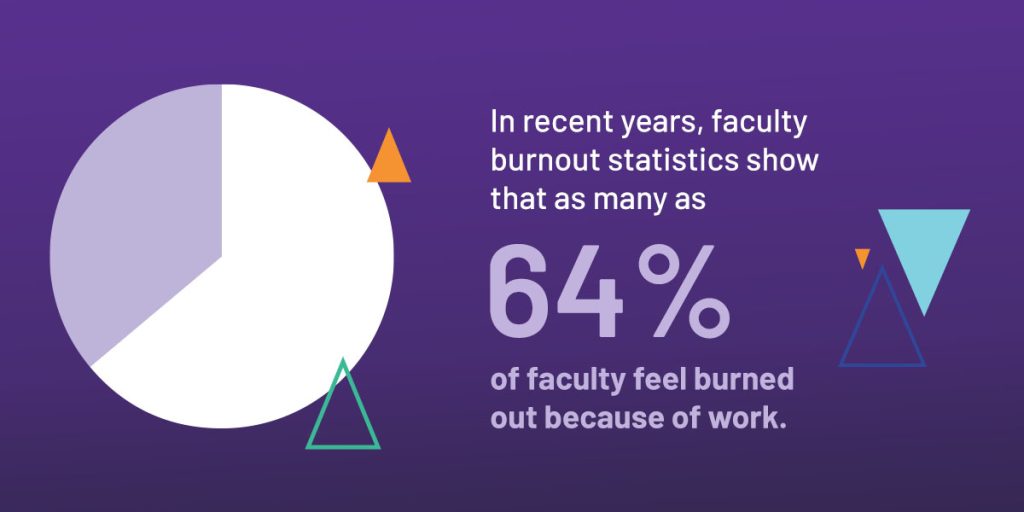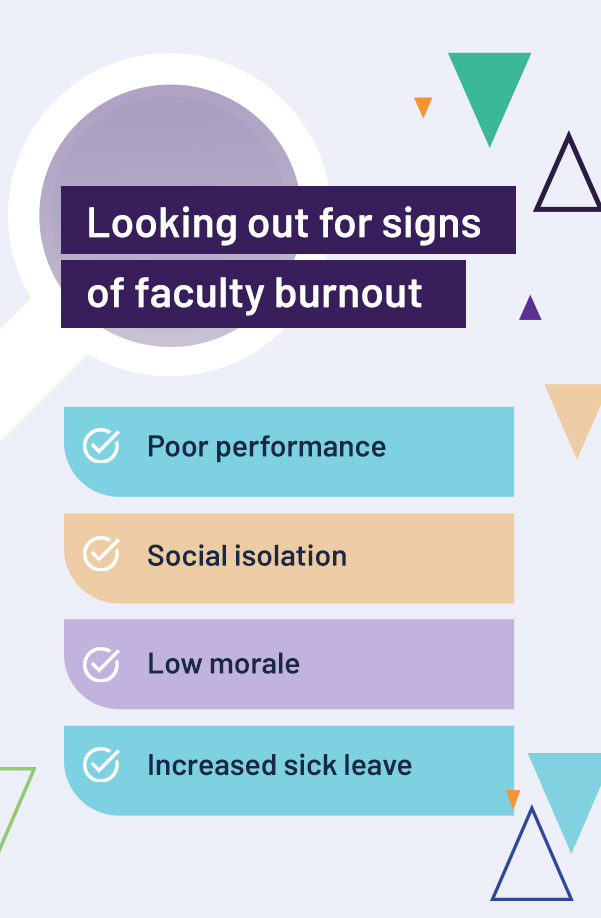




Burnout is a reality many higher education faculty face today. As faculty deal with increased demands for their time with inadequate support and resources, they check out emotionally and physically. It’s not just a trending term — burnout is a barrier that can block your staff and organization from success.
Stay ahead of burnout by learning more about the phenomenon in this article. You’ll discover what causes it, how to spot it, and effective prevention strategies to keep your institution’s faculty happy and healthy.
Most people have busy lives that can sometimes make them feel tired and overwhelmed. However, burnout happens when people forget to care for themselves and these feelings intensify to chronic exhaustion, frustration, and stress. You enter an emotional and physical state where you feel depleted, fatigued, and emotionally drained. Over time, burnout can negatively impact your health and mental well-being.
Burnout is easy to mistake for depression as they share some symptoms. Depression is a mental health condition that causes long bouts of negative feelings and thoughts that require medical intervention to improve. Burnout is often the result of workplace demands and stress. While the two conditions differ, burnout is a serious issue that can lead to depression in the long term. With the right coping mechanisms and adjustments, people with burnout can recover and return to their best selves.
Burnout is prevalent in higher education institutions. In recent years, faculty burnout statistics show that as many as 64 percent of faculty feel burned out because of work. Various factors related to work culture and requirements can cause burnout:

Besides its impact on the lives and careers of faculty, burnout can also negatively affect higher education intuitions. When the majority of faculty feel burned out, administrators may see a decline in:
It can be hard to tell when faculty are not coping because of the work environment. However, there are some common faculty burnout symptoms and signs that you can keep a look out for:

A proactive approach to faculty burnout can help prevent it in your institution. Use the advice below to look after your faculty and ensure they stay happy and engaged in their roles.
Overwhelming workloads and increased overtime demands can quickly exhaust faculty. Administrators must focus on creating a culture that values quality over quantity to reduce the risk of burnout.
Start by assessing faculty workloads across your organization. Look for staff with more demanding teaching loads than others and adjust accordingly. You may have to reduce class size and course assignments for some members or hire additional staff to alleviate the burden on current faculty. It’s also helpful to prioritize tasks for faculty so they know where to focus their energy. Regularly reassess workloads to ensure they remain balanced and manageable.
Technology can cause faculty burnout, but with careful implementation and management, it can also be the solution. Faculty spend a lot of time collecting and recording data on themselves and students. Digitization is an effective strategy for reducing this administrative burden on staff. With various software, your institution can simplify and speed up repetitive tasks, saving faculty time and effort.
Before implementing new technology and software, it’s a good idea to create a comprehensive change management plan. This plan should cover rollout schedules, training, and support for staff members. Creating a plan beforehand can ensure a seamless transition, minimize disruptions, and reduce frustration.
Work-life balance is critical for preventing burnout, but many faculty members struggle to separate their personal and professional lives. Improving this balance requires commitment from both the institution and its employees. You’ll need to encourage faculty to prioritize their personal lives and give them the tools to do so.
For example, you can educate staff members on the importance of a healthy work-life balance. Then, implement changes to support this initiative — limit overtime requirements, establish communication hours, provide time management training, or offer extra paid leave. Encourage faculty to set boundaries, take breaks during work, and use their leave.
Faculty members may suffer in silence if they fear poor mental health will affect their job safety. Without getting the help and support they need, their situation can get worse. Instead of waiting for staff to reach their breakpoint, your institution can offer mental health support proactively. Give staff the option to take time off for their mental health and provide stipends so they can access mental health services.
Offering mental health services on campus for students can also help. Students with access to professional care can better cope with course demands and rely less on faculty for support.
Faculty may also become burned out from their work if they feel their employer does not value their contributions. Offering specific, meaningful verbal praise is a simple way to make faculty feel appreciated. However, praise can fall flat if faculty are overworked, underpaid, and stressed. Address issues affecting their happiness at work to increase the effectiveness of praise.
Other ways to thank faculty for their hard work include bonuses, time off, travel stipends, and new equipment.
Communication is the key to keeping faculty burnout at bay. By checking in with staff regularly, you can stay ahead of how they feel and fix any issues as they arise. Use surveys and feedback forms to get this information quickly. However, one-on-one, in-person discussions can provide a deeper understanding of their situation. Focus on creating a welcoming, judgment-free atmosphere where faculty feel safe opening up.

If faculty face discrimination and disrespect at work, they can become isolated, stressed, and demotivated. Institutions can focus on creating a positive workplace culture that values collaboration and respect to decrease the likelihood of burnout. To discover the issues in your culture, create anonymous feedback channels and encourage staff to share their experiences.
Decrease workplace bias and discrimination by providing anti-discrimination training to all staff members. This strategy can also help you hire more diverse faculty that bring new ideas and perspectives to your institution. You can increase respect and encourage staff to form relationships by offering team-building exercises. Mentorship programs are also effective as they facilitate support and knowledge sharing between faculty members.
Flexible work policies can also help you prevent burnout and encourage better work-life balance. Flexible schedules are customizable to suit individual employee needs. You can allow faculty to choose the work hours that suit their working habits. Even set work hours they can adjust periodically are attractive to faculty. You may also want to let faculty do their work from home where possible if that’s something they prefer.
Increasing salaries may seem like an expensive fix, but it’s a highly effective way to increase job satisfaction and prevent burnout. It’s also crucial to pay faculty fairly and competitively to improve equity and attract top talent to your institution.
Conduct a pay assessment to understand your current compensation structure and discover wage gaps. Then, analyze market data and compare staff salaries to the industry’s average rates. You can also research which benefits are the most sought-after. Finally, adjust compensation packages to reflect skill level and market trends.
Faculty can become burned out if there is no room for growth at your institution. Address the issue by establishing clear career pathways and requirements for faculty members. A guided career pathway can help faculty understand what they must prioritize to succeed and motivate them to develop their skills.
Your institution can also invest in faculty development programs to ensure faculty grow and achieve their professional goals. Their development will help your institution provide a higher quality education to students.

At Watermark, we create award-winning solutions to help institutions support their faculty and students. The Watermark Faculty Success software simplifies data collection so you can uncover deeper insights into your faculty. These insights help you understand each faculty member’s contributions and how to keep them motivated, engaged, and happy.
Faculty Success also makes it easy to track faculty activity, conduct self-studies, manage reviews, and recognize accomplishments. You’ll be able to support faculty as they grow and decrease the chance of burnout. If a staff member does show signs of burnout, our software can help you identify and address it before it becomes an issue.
Request a live demo of Faculty Success to see it in action!






























































































































































































































































































































































































Submit this form to schedule a meeting with one of our reps to learn more about our solutions. If you need customer support instead, click here.